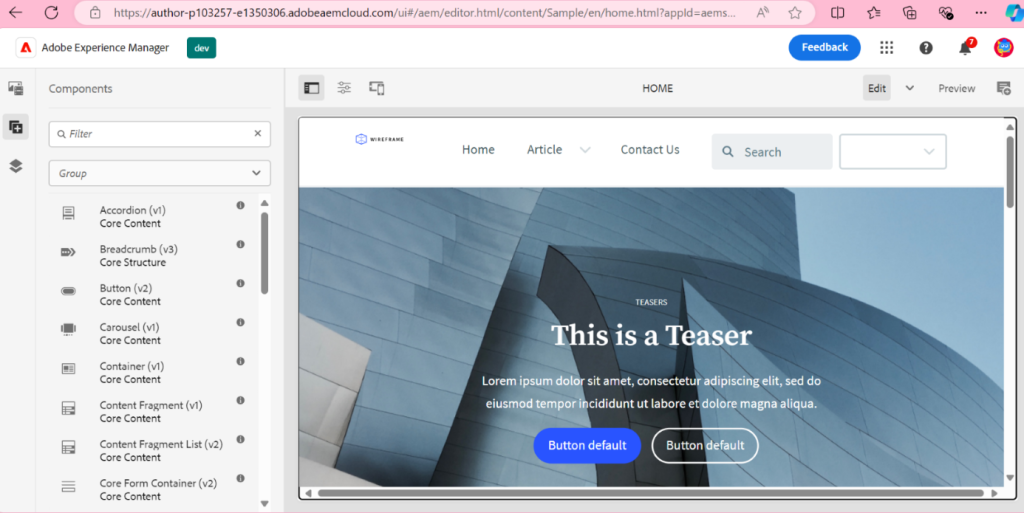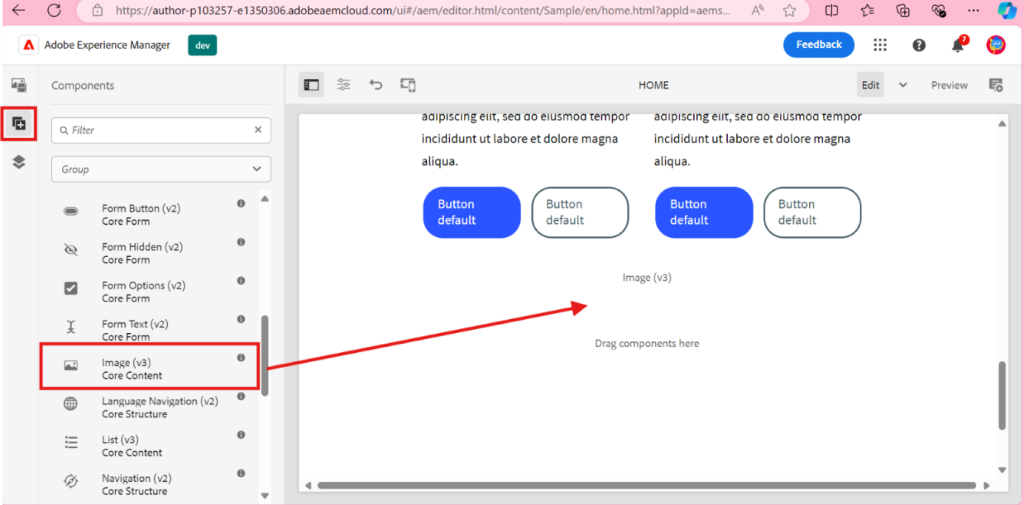Adobe Experience Manager (AEM) is a comprehensive content management system (CMS) that enables organizations to create, edit, publish, and manage digital assets across channels. The tool is particularly useful for marketers who need an easy-to-use system to plan and publish content efficiently.
In the article, I would like to mention one of the key elements of AEM: the author instance, which plays a central role in content creation and editing.
What is an author instance?
Adobe’s documentation emphasizes that the authoring environment is primarily for content creation and management, which is not limited to pages but also includes assets and configurations. It allows users to manage:
- workflows,
- the content lifecycle,
- and other administrative tasks, such as previewing and publishing content.
Importantly, all of these activities take place in a secure environment where users have appropriate access rights, ensuring data protection and minimizing the risk of errors. Regular backups and the ability to quickly restore data during a disaster are an additional guarantee of security, which is essential for key marketing materials such as quarterly reports or advertising campaigns.
The author’s instance at AEM is a kind of “command center” for marketing teams. Here, decisions are made about the structure, design, and content of websites, enabling the effective management of large campaigns and multiple sites. Multiple tasks can be performed on this content depending on how the instance and personal access rights are configured.

TOP 5 functions for the Marketing department
Content editors and entire marketing departments responsible for publishing quarterly reports for their organization must have an effective content management tool.
Implementing five key features of the content management system (CMS) in Adobe Experience Manager (AEM) has significantly improved my productivity when creating this type of content.
Below, I highlight how these features can support the process of creating and publishing reports, ensuring accuracy, consistency, and compliance with organizational requirements.
1. WYSIWYG editor (What You See Is What You Get)
Intuitive interface that allows editors to easily create and format text, images and tables without needing HTML or coding knowledge. Enabled quick drafting, reviewing, and making changes to report content while maintaining the visual structure of the report.

2. Version control and history tracking
This feature allowed marketers to track changes made to the report, review previous versions, and quickly return to earlier editions if needed. This is especially important for a quarterly report, where accuracy and accountability are critical.
3. Scheduling and automated publishing
Marketing teams had to schedule the publication of reports in advance. The ability to schedule publication for a specific time ensured that the report would be published according to marketing campaigns or deadlines without the need for manual intervention.
4. Approval process
The built-in approval process enabled multiple stakeholders (e.g., legal, finance, and management) to review and approve content before publication. This ensured that all content met compliance, branding, and quality standards before release.
5. Customizable templates
Having pre-designed report templates ensured brand consistency, reduced design time, and simplified content creation. Templates with dynamic components made updating data, charts, or other elements easy with minimal effort.
Performance and scalability
It’s worth noting that with the AEM Cloud, which is now the dominant solution, Adobe is responsible for most of the performance and scalability issues. As a result, marketers can focus on content creation while the platform handles performance optimization.
Author instance vs. publish instance – key differences

Although the author instance and the publish instance work together, they have different roles.
| Criterion | Author Instance | Instance of publication |
| Destination | Create, edit and manage content | Deliver published content to end users |
| User access | Access is available to authors, administrators, editors | Public access – end users see live content |
| User interface | WYSIWYG graphical interface for editing and management | End users see only finished pages without editing options |
| Replication of content | Sending content to publication instances via replication agents | Receives content from author instance and makes it available to the public |
| Schedule management | Ability to schedule publications and manage content versions | Publish content on schedule and update quickly |
| Security | Access is limited to internal users | Public access – vulnerable to external attacks require security features |
| Test environment | Used for testing and previewing content before publication | Content is already available to the public, no testing in this environment |
Best practices in managing the Author’s Instance
In order for the author’s instance to work effectively, it is recommended to implement several best practices:
- Performance parameters and security features should be adjusted accordingly.
- It’s worth using clear roles and permissions divisions to avoid unnecessary content management mistakes.
- Regularly monitoring system status and analyzing reports can help quickly identify problems and counteract failures.
Edge Delivery Services – new opportunities for content authors
Edge Delivery Services is a new tool for content authors in Adobe Experience Manager. A global CDN enables faster content delivery to end users, improving their experience and site performance.
The tool optimizes dynamic content, enables better caching management, and allows for quick updates, giving authors more control over the content they publish. Using Edge Delivery, authors can rest assured that their sites will run smoothly, even under heavy load. How will such solutions affect future content delivery standards? We don’t know yet, but it is definitely a tool worth watching.
Summary
Adobe Experience Manager (AEM) is a tool that enables the effective creation and management of content on a website. Author Instance, a key part of AEM, provides organizations with a secure environment for creating, editing, and managing content. With advanced features such as version management, process automation through workflows, and integration with analytical tools, AEM has become an indispensable tool for both the publication of official reports and daily work on marketing campaigns.
Flexible management of components and templates, performance monitoring, and author instance scalability allow the platform to adapt to the organization’s changing needs. In addition, features such as Edge Delivery Services improve performance and user experience, a promising direction for content delivery.
For marketing teams, this means greater control over content and the ability to respond quickly to market needs.
















Leave a comment